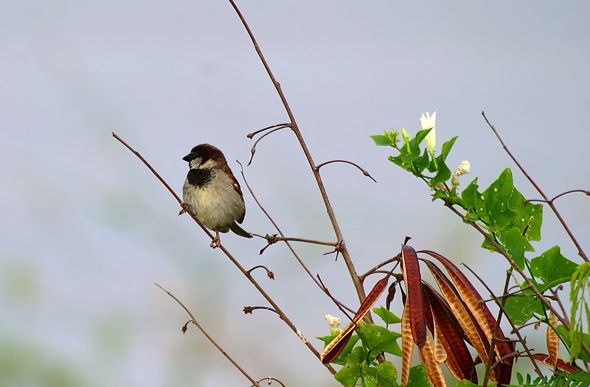There are more homosexual relationships among birds than most people are aware of. According to MacFalane et al. (2010) LINK, more than 130 species of birds indulge in homosexual activity. Up to 38% of these species indulge in female–female sexual activities and as high as 82% in male–male behaviour. In some species, nearly one-third of all sexual endeavours are female–female, and up to two-thirds are male–male. However, heterosexual sexual activities remain the norm.
Among the Black Swan (Cygnus atratus) of Australia, about 25% of all pairs have been estimated to be homosexual. These swans regularly steal nests or form temporary threesomes with females to obtain eggs, driving away the female after she lays her eggs LINK.
Samples of species where homosexuality has been observed include Canada Goose, chicken, Cattle Egret, crane, Emu, Grey Heron, Great Cormorant, House Sparrow (above), Little Egret, Mallard, Ostrich, Pied Kingfisher, Rock Dove, Rose-ringed Parakeet and Tree Swallow LINK.
Local birders became aware of homosexuality in birds back as 2006 when we posted an account of the behaviour of a Great Hornbill (Buceros bicornis) and a Rhinoceros Hornbill (B. rhinoceros), both females and both escapees, in a patch of wild growth at Eng Neo LINK (above: Rhinoceros Hornbill above, Great Hornbill below). The Great Hornbill, playing the role of the male, tried to persuade the Rhinocerous Hornbill to enter a nesting hole in an old albizia tree (Paraserianthes falcataria). This is the typical breeding behaviour of hornbills as the female is confined inside the cavity during the entire period of raising the chicks.
This interspecific homosexuality most probably developed as a result of loneliness as there were no other individuals of the species flying free. After all, loneliness in swans has been speculated as a cause of homosexuality (Rees, 1996) LINK.
Brief background on the subject has been posted HERE.
Credit: YC Wee (text, sparrow image), Chan Yoke Meng (hornbill image).
References:
1. MacFalane, G. R., S. P. Blomberg & P. L. Vasey, 2010. Homosexual behaviour in birds: frequency of expression is related to parental care disparity between the sexes. Animal Behaviour. 80(3), 375-390.
2. Rees, Eileen, 1996. Mate fidelity in swans, an interspecific comparison”. In J. M. Black. Partnerships in birds: The study of monogamy. Oxford: Oxford University Press. pp. 118–122.
Birds engage in all kinds of same-sex hanky panky, from elaborate courtship displays to mounting and genital contact to setting up house together. In some species the same-sex pairs even raise young (conceived with outside partners, obviously) and stay together for several years.



![G-R Hornbill play, Linden [CYM] 060407 - 2 - Version 2](https://besgroup.org/wp-content/uploads/G-R-Hornbill-play-Linden-CYM-060407-2-Version-2.jpg)







One Response